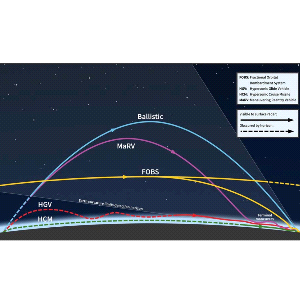About Hypersonic weapons …
Amsterdam, NL - April 25, 2023 -
Hypersonic weapons, which are projectiles or missiles that travel at speeds of at least Mach 5, have gained attention in recent years due to their potential to pierce air and missile defences. The most important types of hypersonic weapons are hypersonic gliders and hypersonic cruise missiles. Hypersonic gliders are glider-like projectiles that are launched into space by a booster rocket and then accelerate to hypersonic speeds by gliding and bouncing on the atmosphere until they reach their target. Hypersonic cruise missiles, on the other hand, are cruise missiles with special air-breathing engines that enable them to fly at hypersonic speeds.
Hypersonic weapons offer several advantages over traditional ballistic missiles and cruise missiles. They combine the speed of ballistic missiles with the manoeuvrability of cruise missiles, making them highly effective at penetrating modern air defence networks. They also reduce reaction time and can hit time-sensitive targets much faster than cruise missiles. Hypersonic weapons can be launched from various platforms, including ships, submarines, aircraft, and trucks.
The development of hypersonic weapons has been a subject of competition among major military powers, with the US and China being at the forefront of research and development. In 2019, the US rated the technological maturity of hypersonic gliders at 5 out of 9, with expectations to reach level 6 out of 9 in 2020, which is considered a low risk for starting system development. However, China has already tested a working prototype of a hypersonic glider in 2021, indicating that it may have surpassed the US in hypersonic glider technological development.
The engines used in hypersonic cruise missiles are different from traditional jet engines, as they need to withstand the stresses of hypersonic flight. Jet engines, which are commonly used in lower-speed aircraft, have compressors to compress air for efficient combustion, but they are heavier compared to engines built for higher speeds. Hypersonic cruise missiles require specialized air-breathing engines that can operate at hypersonic speeds, making them more difficult to intercept and track, and enabling them to have short time-to-impact capabilities.
In conclusion, hypersonic weapons are a disruptive technology with the potential to significantly impact modern warfare. Their combination of speed, manoeuvrability, and ability to penetrate air and missile defences make them highly effective and challenging to defend against. The development of hypersonic weapons has become a competitive race among major military powers, with the US, China, and other countries investing heavily in research and development. The technological maturity of hypersonic weapons is still evolving, with China making significant strides in recent years. As hypersonic weapons continue to advance, they are likely to shape the future of military strategies and operations.
More on Hypersonic Weapon technologies and market players and the market developments is available in Amsterdam based Market Forecast’s latest study “Hypersonic Weapons - Market and Technology Forecast to 2030”.

Image Source: CSIS Missile Defense Project (Trajectories not to scale)
Related Studies
